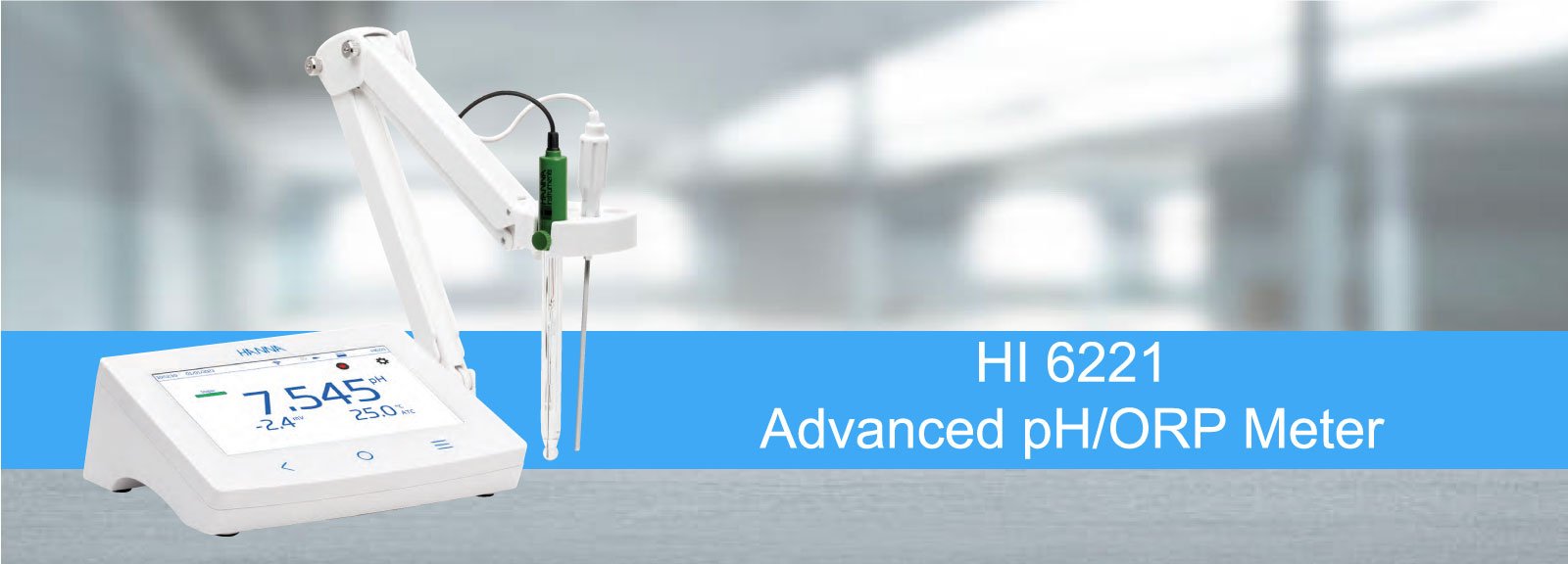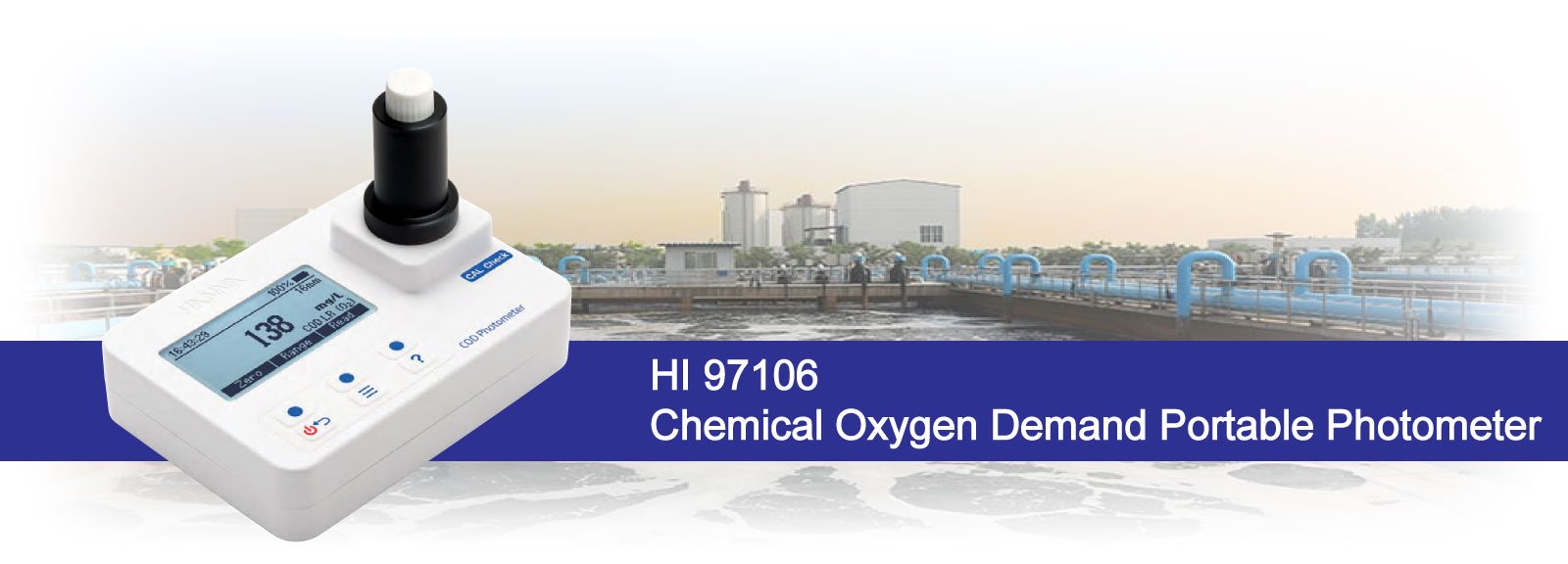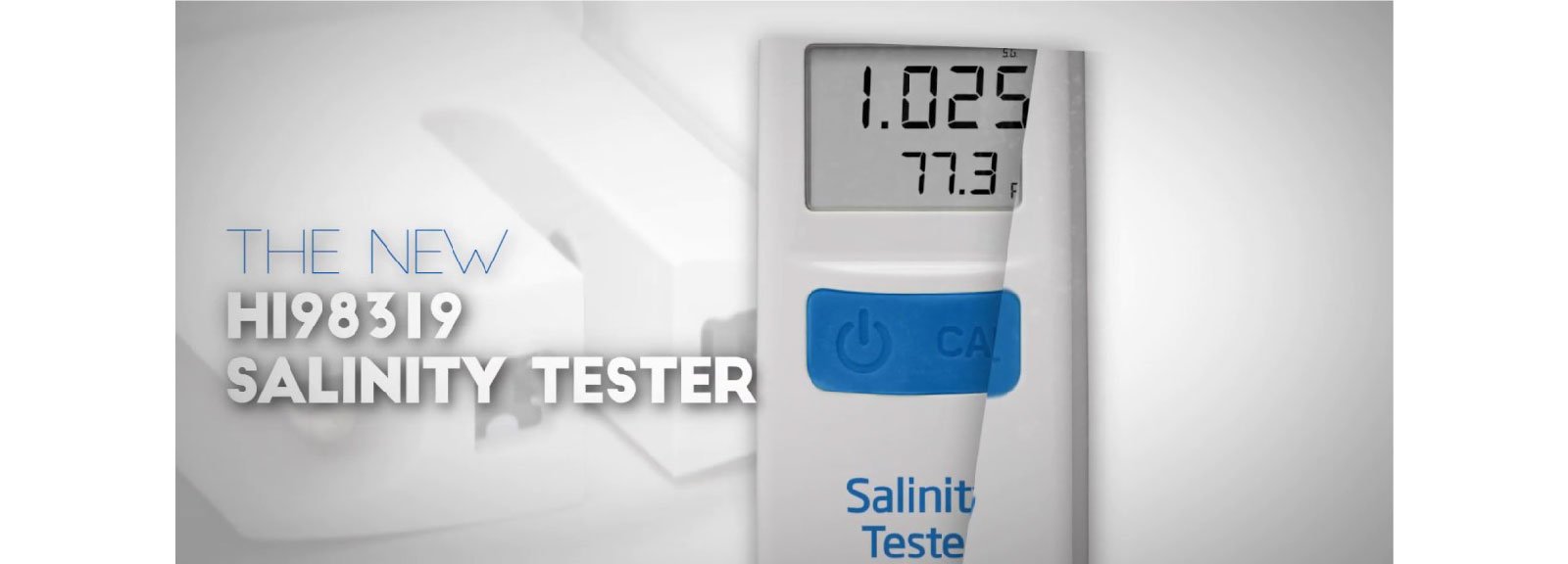11A, Jalan PJS 11/20,
Bandar Sunway,
46150 Petaling Jaya,
Selangor, Malaysia.
Hanna Instruments (M) Sdn Bhd
N0. 303-2-27, Krystal Point,
Jalan Sultan Azlan Shah,
11900 Sungai Nibong,
Penang, Malaysia.
+604-638 4558
+604-645 4558
penang@hannamalaysia.com
Sabah Branch Office
Hanna Instruments (M) Sdn Bhd
No. 4-1, 1st Floor,
Plaza Kingfisher,
Jalan Plaza Kingfisher 5,
Inanam, 88450 Kota Kinabalu,
Sabah, East Malaysia.
088-382 941
088-382 942
sabah@hannamalaysia.com
HI93102 Portable Multiparameter Turbidity and Ion Specific Meter
| Previous | 5 / 7 | Next |
RM 6,600.00
The HI93102 is a portable multiparameter meter that measures turbidity, free and total chlorine, cyanuric acid, pH, iodine, bromine, and low range iron. This meter combines accuracy and ease of use in an ergonomic, portable design. A user can accurately determine the turbidity after calibration with AMCO-AEPA-1 standards; determination of free chlorine, total chlorine, cyanuric acid, pH, iodine, bromine, and low range iron is reliable and consistent with the use of ready made reagents.
- EPA Compliant Turbidity Method
- Custom Calibration Points
- Logging Mode
The most important parameters needed for water analysis, especially in drinking water, can be measured with Hanna’s HI93102 portable meter. This instrument not only measures turbidity, but also free and total chlorine, cyanuric acid, pH, iodine, bromine, and low range iron. Measurements are made quickly and accurately through a sophisticated, yet easy-to-use microprocessor. Users can select between pre-programmed calibration values or calibration points can be customized at a specified concentration or relative absorbance of the sample.
The HI93102 offers many features that appeal to use in the field as well as in laboratory settings. The exclusive cuvette locking system ensures that the cuvette is inserted into the measurement cell in the same position every time to maintain a consistent path length. Up to 25 measured samples can be stored in memory, together with time and date. Miniaturization of the electronics has made it possible to o‰ffer unsurpassed accuracy and quality in a portable unit weighing just one pound.
Features at-a-glance
AMCO AEPA-1 Primary Turbidity Standard - The AMCO AEPA-1 standards for the turbidity range of the HI93102 are recognized as a primary standard by the USEPA. These non-toxic standards are made of styrene divinylbenzene polymer spheres that are uniform in size and density. The standards are reusable and stable with a long shelf life.
Logging – The HI93102 allows users to log up to 25 measurement readings. Measurement logs can easily be recalled with the press of a button and a reminder will appear if the memory becomes full. The logging mode can be enabled or disabled.
GLP – With a press of the “GLP” button on the face of the meter, users can view the date, time, and two calibration values of the current mode.
Auto-shut Off - Automatic shut off is selectable after 10, 20, 30, 40, 50, or 60 minutes of non-use when the meter is in measurement mode. This feature prevents wastage of batteries in the event the meter is accidentally left on.
Battery Status Indicator - The status of the battery is monitored during every measurement cycle. An indicator will warn the user when the amount of battery life left is not sufficient to take reliable measurements.
Error Codes – Helpful diagnostic codes appear on the display alerting to problems including low light, high light, or sample out of range.
Significance of Use
Turbidity, free and total chlorine, cyanuric acid, pH, iodine, bromine, and low range iron are all critical parameters that can be tested to ensure good water quality in drinking water, wastewater, and water used for pools and spas.
Turbidity is one of the most important parameters used to determine the quality of drinking water. Once considered as a mostly aesthetic characteristic of drinking water, signi˜ficant evidence exists that controlling turbidity is a competent safeguard against pathogens. In natural water, turbidity measurements are taken to gauge general water quality and its compatibility in applications involving aquatic organisms.
Chlorine is one of the most commonly used disinfectants for water treatment. It can be added to in various forms including calcium hypochlorite, sodium hypochlorite, or in some instances, chlorine gas. When added to water, chlorine creates hypochlorous acid (HOCl) which dissociates into hypochlorite ion (OCl-).
HOCl ↔ H+ + OCl-
hypochlorous acid ↔ hydrogen ion + hypochlorite ion
HOCl is the form of chlorine that acts as a stronger disinfectant as compared to OCl-. To ensure the added chlorine is effective at sanitizing, the pH of the water must be taken into account. Around pH 7.5, HOCl and OCl- are present in relatively equal amounts. Below pH 7.5, the equilibrium shifts to favor HOCl; above pH 7.5, the equilibrium shifts to favor OCl-. Depending on the application, addition of chlorine is effective when added to water with a neutral or slightly acidic pH value.
When chlorine is first added to water, it is available as free chlorine. The measurement of free chlorine signifies the amount available for disinfection. Once chlorine begins to sanitize bacteria and pathogens present in the water, it becomes combined chlorine; combined chlorine is no longer available to act as a disinfectant. The measurement of total chlorine signifies the amount of free chlorine and combined chlorine. With both free and total chlorine measurements, a drinking water operator or pool owner can determine if there is enough chlorine available for disinfection.
Cyanuric acid is best known as a stabilizing reagent for chlorine. It is widely applied in swimming pool and spa treatment programs to slow down the decomposition of hypochlorous acid. In outside pool areas, this process is accelerated by the effects of UV rays. When applied properly it can save up to 80% of normal chlorine consumption in pools during peak months.
Bromine is less volatile and more stable than chlorine, making it a good choice as a disinfectant in pools, spas, and hot tubs, and a sanitizing agent in drinking water systems. Like chlorine, excess amounts of bromine in water can be dangerous to health and can cause eye irritation. Daily monitoring of bromine concentration prevents damage to equipment and contributes to the optimization and efficiency of the process while providing for increased user safety.
Iron is naturally present in water in low concentrations, but it reaches high concentrations in wastewater effluents. The iron concentration in water needs to be monitored because it becomes harmful above certain levels. In domestic water, for instance, iron can stain laundry, damage kitchenware, favor the growth of certain bacteria, and unpleasantly alter the taste of water. Iron is also an indicator of ongoing corrosion in water cooling and heating systems. Moreover, iron is normally monitored in mining wastewater to avoid contamination.
Principle of Operation
When measuring turbidity, the light beam that passes through the sample is scattered in all directions. The intensity and pattern of the scattered light is a‰ffected by many variables, such as wavelength of the incident light, particle size and shape, refractive index, and color. The optical system of the HI93102 includes an LED light source and a scattered light detector (90°).
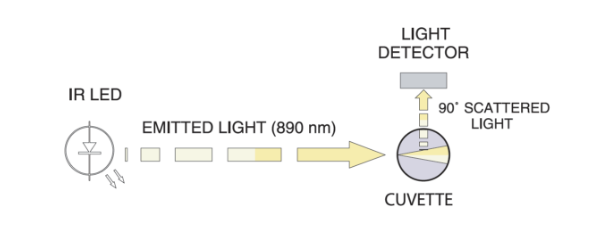
Principle of Operation: Colorimetric Mode
When measuring specific ions in colorimetric mode, a parameter-specific reagent is added to the sample, displaying a color change; the greater the concentration, the deeper the color. The associated color change is then colorimetrically analyzed according to the Beer-Lambert Law. This principle states that light is absorbed by a complementary color, and the emitted radiation is dependent upon concentration. For determination of free and total chlorine, cyanuric acid, pH, iodine, bromine, and low range iron, a narrow band interference filter at 525 nm (green) allows only green light to be detected by the silicon photodetector and omits all other visible light emitted from the light source. As the change in color of the reacted sample increases, absorbance of the specific wavelength of light also increases, while transmittance decreases.
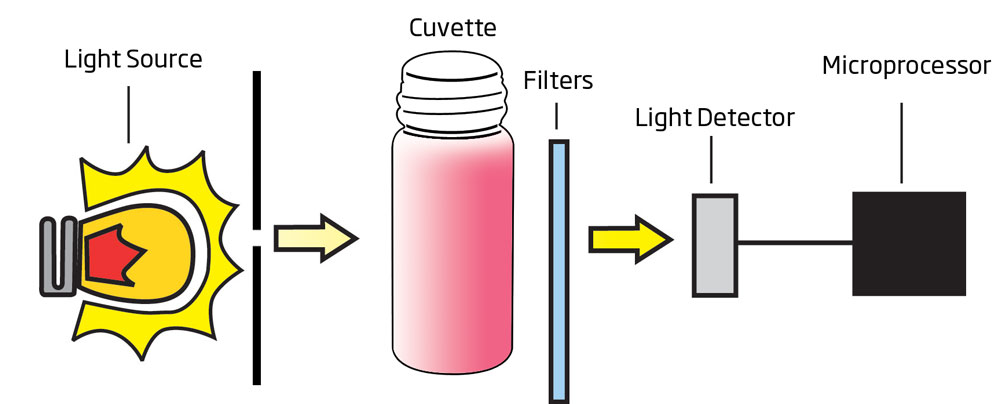
| SKU | HI93102 |
|---|---|
| Product Name | Portable Multiparameter Turbidity and Ion Specific Meter - HI93102 |
| Quote Required | Yes |
| pH Range | 5.9 to 8.5 pH |
| pH Resolution | 0.1 pH |
| pH Accuracy | ±0.1 pH |
| pH Method | Phenol red method. The reaction with reagents causes a red tint in the sample. |
| Turbidity Range | 0.00 to 50.0 NTU |
| Turbidity Resolution | 0.01 (0.00 to 9.99); 0.1 NTU (10.0 to 50.0) |
| Turbidity Accuracy | ±0.5 NTU or ±5% of reading (whichever is greater) |
| Turbidity Calibration | two-point; selectable between 0.00 - 50.0 FTU (0.00 and 20.0 FTU recommended) |
| Turbidity Light Source | pure green LED |
| Turbidity Light Detector | silicon photocell |
| Bromine Range | 0.00 to 8.00 mg/L |
| Bromine Resolution | 0.01 mg/L |
| Bromine Accuracy | ±0.08 mg/L (ppm); ±3% of reading |
| Bromine Method | Adaptation of the Standard Methods for the Examination of Water and Wastewater, 20th edition, DPD method. The reaction between bromine and the reagent causes a pink tint in the sample. |
| Free Chlorine Range | 0.00 to 2.50 mg/L |
| Free Chlorine Resolution | 0.01 mg/L |
| Free Chlorine Accuracy | ±0.03 mg/L (ppm); ±3% of reading |
| Total Chlorine Range | 0.00 to 3.50 mg/L |
| Total Chlorine Resolution | 0.01 mg/L |
| Total Chlorine Accuracy | ±0.03 mg/L (ppm); ±3% of reading |
| Chlorine Method | adaptation of the USEPA method 330.5 and Standard Method 4500-Cl G. The reaction between chlorine and the reagents causes a pink tint in the sample. |
| Cyanuric Acid Range | 0 to 80 mg/L |
| Cyanuric Acid Resolution | 1 mg/L |
| Cyanuric Acid Accuracy | ±1 mg/L (ppm); ±15% of reading |
| Cyanuric Acid Method | Adaptation of the turbidimetric method. The reaction between cyanuric acid and the reagent causes a white suspension in the sample. |
| Iodine Range | 0.0 to 12.5 mg/L |
| Iodine Resolution | 0.1 mg/L |
| Iodine Accuracy | ±0.1 mg/L (ppm); ±5% of reading |
| Iodine Method | Adaptation of the Standard Methods for the Examination of Water and Wastewater, 20th edition, DPD method. The reaction between iodine and the reagent causes a pink tint in the sample. |
| Iron Range | 0.00 to 1.00 mg/L |
| Iron Resolution | 0.01 mg/L |
| Iron Accuracy | ±0.02 mg/L (ppm); ±3% of reading |
| Iron Method | Adaptation of the TPTZ method. The reaction between iron and the reagent causes a violet tint in the sample. |
| Photometer/Colorimeter Light Source | pure green LED |
| Photometer/Colorimeter Light Detector | silicon photocell |
| Battery Type/Life | 4 (1.5V) AA / approximately 60 hours of continuous use or 1000 measurements |
| Automatic Shut-Off | automatic shut-off selectable after 10, 20, 30, 40, 50 or 60 minutes of non-use |
| Environment | 0 to 50°C (32 to 122°F); RH max 95% (non condensing) |
| Weight | 510 g (1.1 lb.) |
| Dimensions | 220 x 82 x 66 mm (8.7 x 3.2 x 2.6’’) |
| Ordering Information | HI93102 is supplied with measurement cuvette cap, batteries and instruction manual. |

